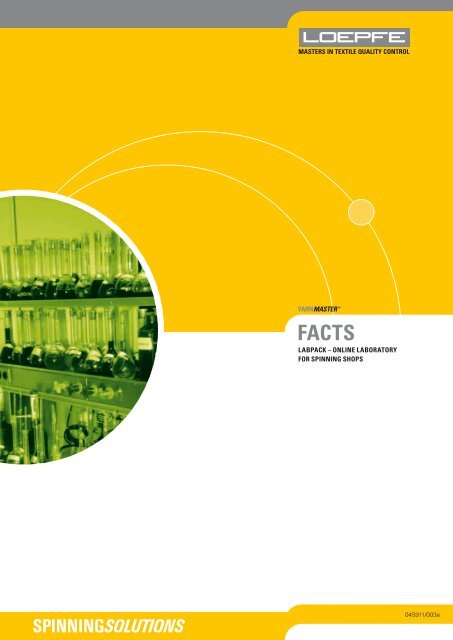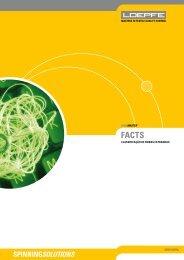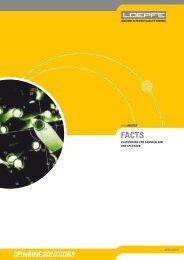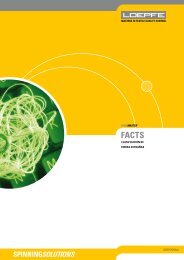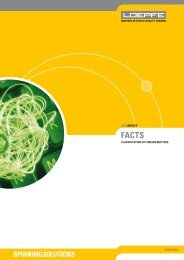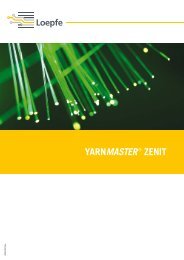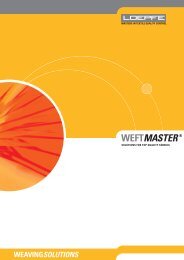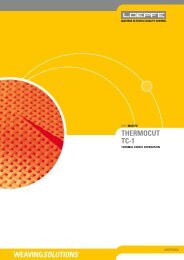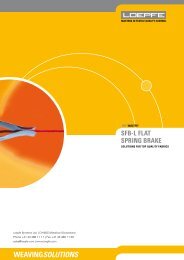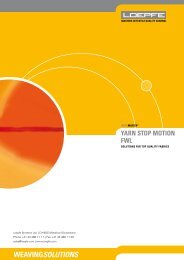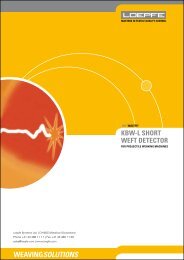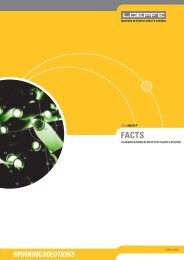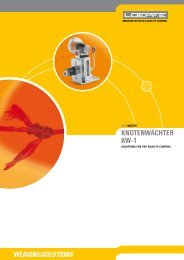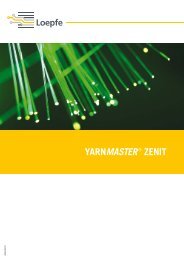online laboratory - Loepfe Brothers Ltd.
online laboratory - Loepfe Brothers Ltd.
online laboratory - Loepfe Brothers Ltd.
Create successful ePaper yourself
Turn your PDF publications into a flip-book with our unique Google optimized e-Paper software.
Masters Masters in textile Quality Control<br />
Masters in textile Quality Control<br />
yarnMASTER ®<br />
Digital <strong>online</strong> Quality Control<br />
yarnMASTER ®<br />
Digital <strong>online</strong> Quality Control<br />
faCts<br />
yarnMASTER ®<br />
labPaCk – <strong>online</strong> <strong>laboratory</strong><br />
Digital <strong>online</strong> Quality Control<br />
for sPinning shoPs<br />
yarnMASTER ®<br />
Digital <strong>online</strong> Quality Control<br />
045911/003e
labPaCk – <strong>online</strong> <strong>laboratory</strong><br />
yarnMASTER ®<br />
Digital <strong>online</strong> Quality Control<br />
yarnMASTER ®<br />
Digital <strong>online</strong> Quality Control<br />
yarnMASTER ®<br />
Digital <strong>online</strong> Quality Control<br />
yarnMASTER ®<br />
Digital <strong>online</strong> Quality Control<br />
a clear change in yarn manufacture<br />
has been emerging over the past years:<br />
Quality assurance and control have<br />
shifted from the <strong>laboratory</strong> directly <strong>online</strong><br />
into the production process.<br />
the labPack strengthens loePfe's<br />
market leadership in yarn clearers and<br />
<strong>online</strong> quality monitoring.<br />
labPack counts the so-called imperfections<br />
and monitors and evaluates the<br />
yarn surface.<br />
advantages<br />
This complete quality monitoring provides<br />
information on raw material and machine<br />
parameters, for example on wear in the<br />
traveler system. A further advantage is<br />
reliable detection, and separation when<br />
necessary, of off-standard bobbins during<br />
the winding process.
iMPerfeCtions<br />
Staple fiber yarns often have "imperfections" as frequent smaller<br />
yarn faults or irregularities. These can be divided into three<br />
groups:<br />
• Thin places<br />
• Thick places<br />
• Neps<br />
➜ thin and thick places<br />
Together with the impairment of the optical appearance of the<br />
textile surface, the number of thin and thick places is an important<br />
information on the condition of the raw material and/or<br />
manufacturing process.<br />
An increase in the number of thin places does not necessarily<br />
mean that the number of machine standstills increases accordingly<br />
during weaving and knitting with this yarn: In many cases,<br />
thin places indicate larger yarn twists. This means that the<br />
yarn tensile strength must not necessarily decrease proportional<br />
to the reduction in the fiber count.<br />
Thin place Thick place<br />
These types of faults are either in the nature of the raw material<br />
or originate in a suboptimal manufacturing process. Isolated faults<br />
of this type are not regarded as disturbing in the yarn but do however<br />
have a negative effect on cloth appearance when too many<br />
are present.<br />
With thick places, the relations are the other way round: The higher<br />
fiber count in the yarn cross-section results in a higher resistance<br />
to torsion. Thick places therefore frequently have less yarn<br />
twist. The yarn tensile strength in the area of the thick places is<br />
therefore very rarely proportional to the fiber count. Thick places<br />
can be weak points in the weaving and knitting shops that lead<br />
to machine standstills. These considerations are particularly applicable<br />
to ringspun yarns.
➜ neps<br />
Apart from the strong influence on the optical appearance of<br />
textile surface structures, neps from a certain size upwards<br />
also lead to problems in the knitting machine sector. Not only<br />
the size but also the number of neps are decisive criteria as to<br />
whether the yarn is usable or not.<br />
Neps in the raw material are mainly foreign bodies such as, for<br />
example, shell or plant residues, whereas neps in production<br />
are created during the spinning process through unsuitable machine<br />
settings and a bad ambient climate. For example, when<br />
the ambient climate is too dry or deflection points as well as<br />
when fiber parallelism is too high can create neps during manufacturing.<br />
Some of the neps in the raw material remain in the finished<br />
yarn depending on the manufacturing process. Most of the raw<br />
material neps are separated during combing. This means neps<br />
in the finished yarn are mainly from the manufacturing process.<br />
Reliable analysis of imperfections (IPI) therefore not only allows<br />
optimizing manufacturing processes but also to draw conclusions<br />
on the quality of the fiber material used.<br />
➜ irregularity (small)<br />
Yarn irregularity identifies general diameter fluctuations in the<br />
yarn such as thicker and thinner places.<br />
Yarn uniformity is the most important criterion for smooth production<br />
processes with regard to thread characteristics such<br />
as, for example, thick places or fiber fly as well as the physical<br />
yarn characteristics such as fluctuations in yarn count, tensile<br />
strength, elongation and twist.<br />
Increased yarn irregularities have a negative influence on<br />
quality and therefore lead to interruptions in downstream processing<br />
such as, for example, through an increase in thread<br />
breaks. Furthermore, yarn irregularities lead to an unsatisfactory<br />
or even inferior result for woven and knitted fabrics.<br />
Neps<br />
Figure 1:<br />
Imperfection analysis (IPI)<br />
Irregularities
➜ Counting imperfections<br />
LOEPFE's quality assurance system LabPack delivers, <strong>online</strong>,<br />
the number of imperfections (neps, thick and thin places) per<br />
1000 m as well as the irregularities (small per m) of a yarn.<br />
Tests have clearly shown that the LOEPFE <strong>online</strong> counting<br />
of imperfections and irregularities of a ring yarn during the<br />
winding process provides important information on the yarn<br />
quality.<br />
Comparisons document a correlation in the number of imperfections<br />
counted by both test methods offline as well as <strong>online</strong><br />
with LOEPFE's YarnMaster ® system.<br />
Even though the number of effectively registered imperfections<br />
using both test methods deviated from one another due to the<br />
different measuring systems (optical/capacitive), a correlation<br />
factor of 0.92 was determined.<br />
Apart from the diameter-relative imperfections already mentioned,<br />
the YarnMaster ® yarn clearer also classifies length<br />
imperfections (see chart).<br />
D5.00<br />
D3.20<br />
D2.30<br />
D1.80<br />
D1.30<br />
D1.20<br />
D1.00<br />
D0.80<br />
D0.75<br />
D5.00<br />
D3.20<br />
D2.30<br />
D1.80<br />
D1.30<br />
D1.20<br />
D1.00<br />
D0.80<br />
D0.75<br />
0.5 cm 1 cm 2 cm 4 cm 8 cm<br />
Figure 3:<br />
Ranges for diameter-relative imperfections<br />
Frequent events: Nep imperfections<br />
Frequent events: Thick place imperfections<br />
Frequent events: Thin place imperfections<br />
Very frequent events: Small (irregularity)<br />
0.5 cm 1 cm 2 cm 4 cm 8 cm<br />
20 cm 70 cm<br />
20 cm 70 cm<br />
Figure 2:<br />
Lab-Data evaluation from YarnMaster ® control unit.<br />
D5.00<br />
D3.20<br />
D2.30<br />
D1.80<br />
D1.30<br />
D1.20<br />
D1.00<br />
D0.80<br />
D0.75<br />
D5.00<br />
D3.20<br />
D2.30<br />
D1.80<br />
D1.30<br />
D1.20<br />
D1.00<br />
D0.80<br />
D0.75<br />
0.5 cm 1 cm 2 cm 4 cm 8 cm<br />
0.5 cm 1 cm 2 cm 4 cm 8 cm<br />
Figure 4:<br />
Ranges for length-relative imperfections<br />
Imperfections 2–4 cm<br />
Imperfections 4–8 cm<br />
Imperfections 8–20 cm<br />
Imperfections 20 –70 cm<br />
20 cm 70 cm<br />
20 cm 70 cm
surfaCe inDex<br />
➜ The surface of a yarn is characterized by irregularities (thick and<br />
thin) as well as hairiness and neps. In order to be able to forecast<br />
yarn behavior in the weaving or knitting shop, single quality<br />
characteristics such as yarn irregularity are not sufficient to<br />
assess the yarn. Low yarn irregularity alone cannot indicate the<br />
appearance of a textile surface: Higher yarn hairiness is often<br />
first especially clear after dyeing where warp and filling yarns<br />
show different absorption capacities for the dye.<br />
Only a combination of various quality criteria such as, for example,<br />
hairiness or irregularity allow a reliable statement. The quality<br />
characteristics merge within the surface index SFI – a part<br />
of the LabPack. This allows users to monitor quality changes in<br />
surface characteristics <strong>online</strong>. The most important relations and<br />
terms are described in the following.<br />
➜ hairiness<br />
Hairiness is defined by the plurality of fiber loops and ends<br />
sticking out of a yarn. Hairiness as characteristic for spun fiber<br />
yarns is a parameter that mainly depends on the characteristics<br />
of the raw material, spinning shop preparation, spinning process<br />
and method used.<br />
A certain hairiness can be produced as required in downstream<br />
processing depending on the application. This can, on the one<br />
hand, give the fabric a certain effect such a soft touch. On the<br />
other hand, higher or variable hairiness within a lot can cause<br />
an undesired cloudy appearance for the knitted fabrics after<br />
dyeing and finishing.<br />
Higher hairiness in warp yarns can also impede filling insertion<br />
especially on airjet weaving machines. Hairy warp yarns can<br />
stick together and hinder filling yarns from passing through the<br />
weaving shed.<br />
Figure 5:<br />
Microscopic picture of a hairy yarn<br />
hairiness occurs through:<br />
• Wide spinning triangle<br />
• High distortion<br />
• Friction on deflection points (e.g. traveler)<br />
• Unsuitable coverings/aprons<br />
• Dry rooms<br />
• Static electricity<br />
Hairiness
➜ Definitions<br />
Quality variable SFI defines the sum signal of the fibers pro<br />
truding from a yarn within a measured length of 1 cm yarn. The<br />
yarn core diameter is hidden (Figure 6).<br />
Surface index SFI/D used in yarn clearing is defined as the<br />
sum signal of the fibers protruding from the core diameter of a<br />
yarn. The core diameter of the yarn is set to 100% in this case<br />
(Figure 7).<br />
➜ <strong>online</strong> quality monitoring<br />
Quality value SFI enables making a 100% quality statement<br />
as to the surface characteristics of the yarn to be wound. The<br />
comparison between the LOEPFE SFI quality values and a<br />
competitor's product (H) shows that both test methods correlate<br />
(∅ correlation coefficient r = 0.91).<br />
The chart shown is based on a series of measurements with<br />
differing ring yarn qualities and counts.<br />
Figure 6:<br />
The yarn diameter is hidden<br />
Sum signal SFI<br />
Figure 7:<br />
Yarn core diameter 100%<br />
Sum signal SFI/D<br />
10<br />
5<br />
1<br />
Nm<br />
30 35 40 45 50 55 60 65<br />
Figure 8:<br />
∅ correlation coefficient r = 0.91
➜ yarn clearing<br />
During yarn clearing, surface index SFI/D relative to the diameter<br />
allows reliable detection of quality changes with regard to<br />
the surface characteristics of the yarn to be wound. When the<br />
values are above or below limits set as percentages (±) relative<br />
to the SFI/D reference value, offstandard bobbins are detected<br />
and eliminated from production.<br />
The reference value serves as starting point for SFI/D monitoring.<br />
This is either determined continuously by the clearer or<br />
entered by the user (constant) as shown in (Figure 9).<br />
The floating SFI/D reference value (Figure 10) adapts to the<br />
general yarn surface level of a style. This compensates, for<br />
example, surface fluctuations caused by the climatic conditions<br />
and does not lead to excessive cutting counts. Single bobbins<br />
with high deviations from the mean value are detected reliably.<br />
The user defines the constant SFI/D reference value. This value<br />
remains unchanged during the complete production and is not<br />
adapted automatically by the clearer. Stable production conditions<br />
such as, for example, climatic conditions, must be presumed<br />
when using this setting.<br />
➜ Characteristic relations<br />
yarn twist<br />
Surface index SFI sinks as yarn twist increases because more<br />
fiber ends projecting out of the yarn surface are bound.<br />
yarn count<br />
The higher the yarn count, the lower the breaking strength of<br />
a yarn. Fine yarns have a lower number of fibers in yarn crosssection.<br />
Increasing yarn twist provides the required tensile<br />
strength. Tests have shown that the SFI sinks as yarn fineness<br />
increases. The reduction in the diameter of fine yarns has the<br />
following effect on SFI/D values: The relation of the sum signal<br />
(SFI/D), which reflects the fiber ends projecting out of the yarn,<br />
increases as the yarn diameter decreases.<br />
Figure 9:<br />
Limit values<br />
Figure 10:<br />
Reference value setting<br />
➜ Variable CV channel (VCV)<br />
+ limit: 10%<br />
SFI/D reference<br />
-- limit: 12%<br />
-- limit: 12%<br />
SFI/D reference<br />
+ limit: 10%<br />
Disturbing diameter variations caused by drafting faults, soiled<br />
rollers or sporadically occurring irregularities can be detected.<br />
As opposed to <strong>laboratory</strong> practice where check lengths of<br />
400 or 1000 m are normally used for CV determination, the<br />
check length of the VCV can be varied continuously between<br />
1 and 50 m. This allows specific detection of disturbing diameter<br />
variations in this length range.<br />
The clearer calculates continuously the VCV values from the<br />
yarn pieces with the set check length and compares these<br />
against the mean value.
PraCtiCal aPProaCh<br />
➜ Detection of off-standard bobbins<br />
Continuous monitoring and optimization of the production process<br />
are decisive factors for constant yarn quality.<br />
Yarn clearing is vital to meet the increasing demands on yarns.<br />
Extensive tests by yarn manufacturers combined with direct<br />
cooperation with the customer serve to determine the clearing<br />
limits for the respective yarn.<br />
The "SFI/D deviation" determined continuously according to<br />
Figure 11 is available to ensure fast, efficient application of yarn<br />
clearing using the surface index.<br />
This value, specified as a percentage, shows the average surface<br />
distribution of the wound yarn and simplifies determination<br />
or optimization of the SFI/D limits (±).<br />
➜ normal sfi distribution of the bobbin<br />
Tests show that the surface index within a bobbin (base/tip)<br />
is spread up to ± 10%. This can mainly be attributed to the tension<br />
differences during ring spinning. The yarn tensile strength<br />
fluctuates during bobbin winding and the ring rail stroke. The<br />
tensile strength peaks are very large in the area of the bobbin<br />
base. Increasing tension leads to deterioration in yarn irregularity<br />
and IPI values.<br />
These relations must be taken into account when setting the<br />
limit values because such fluctuations do not normally have a<br />
negative influence on quality in the textile surface structure.<br />
Figure 11:<br />
SFI/D deviation<br />
Drafting<br />
assembly<br />
(Outlet)<br />
Bobbin tip<br />
Bobbin base
➜ Detection of periodical faults, high imperfections and irregularity<br />
SFI/D deviations up to 40% can be determined for a periodical fault such as, for<br />
example, a moiré effect, that shows a strong increase in imperfections and/or irregularity<br />
of a yarn.<br />
In this example, a strong increase in irregularity (CVm) and imperfections (IPI) leads<br />
to an SFI/D deviation of +48%. This can be seen clearly as cloudiness on the knitted<br />
fabric surface.<br />
A mass spectrograph shows a periodical fault with 11 m period length.<br />
experience values for sfi yarn clearing<br />
yarn type<br />
Combed ring<br />
yarn<br />
100% Co<br />
experience value<br />
sfi/D setting<br />
Setting: ±20%<br />
Deviation: ±10%<br />
Setting: ±20%<br />
Deviation: ±10%<br />
Compact yarn Setting: ±25%<br />
Deviation: ±15%<br />
Core yarn<br />
(Co/elastan)<br />
Setting: ±25%<br />
Deviation: ±15%<br />
Setting: ±25%<br />
Deviation: ±15%<br />
Setting: ±30%<br />
Deviation: ±25%<br />
Setting: ±30%<br />
Deviation: ±25%<br />
Measured<br />
sfi/D deviation<br />
fault type Cause<br />
Figure 12:<br />
Knitted fabric with reference yarn<br />
Figure 13:<br />
Knitted fabric with + 48% SFI/D deviation<br />
+20% to +34% Periodical fault (Moiré) Ring spinning machine: Drafting<br />
assembly (upper roller defective)<br />
+30% Imperfections IPI (neps) Ring spinning machine: Ring traveler<br />
system (runner defective)<br />
+40% Periodical fault (Moiré) Ring spinning machine: Drafting<br />
assembly (lower apron defective)<br />
+42% IPI, CV (irregularity),<br />
hairiness<br />
Ring spinning machine: Drafting<br />
assembly (soiling in compression zone)<br />
+27% IPI, CV Ring spinning machine:<br />
Drafting assembly (compression<br />
apron defective)<br />
+31% Periodical fault (Moiré) Ring spinning machine: Drafting<br />
assembly (upper roller defective)<br />
+37% IPI, CV Ring spinning machine:<br />
Ring traveler system or roving
➜ Data collection and evaluation<br />
Offline collection and evaluation of quality data in a <strong>laboratory</strong><br />
often involve high material and personnel effort. A meaningful<br />
alternative is to combine <strong>online</strong> quality monitoring with a<br />
central system for data collection (Figure 14).<br />
The LOEPFE MillMaster ® allows data storage and chronological<br />
quality tracking based on graphical representation over a longer<br />
period.<br />
The evaluated data volume is an excellent factor for exact quality<br />
documentation. The LOEPFE MillMaster ® provides an exact<br />
description of the quality because it processes a huge flood<br />
of data and shows the results in graphic form that is easy to<br />
understand.<br />
Figure 14:<br />
Central data collection system MillMaster ®<br />
Figure 15:<br />
MillMaster ® quality progress evaluation
Masters in textile Quality Control<br />
ww.loepfe.com<br />
Masters in textile Quality Control<br />
YarnMaster and MillMaster are registered<br />
trademarks of LOEPFE BROTHERS LTD.<br />
<strong>Loepfe</strong> <strong>Brothers</strong> <strong>Ltd</strong>.<br />
CH8623 Wetzikon/Switzerland<br />
Phone +41 43 488 11 11<br />
Fax +41 43 488 11 00<br />
sales@loepfe.com<br />
www.loepfe.com<br />
Subject to technical modifications


